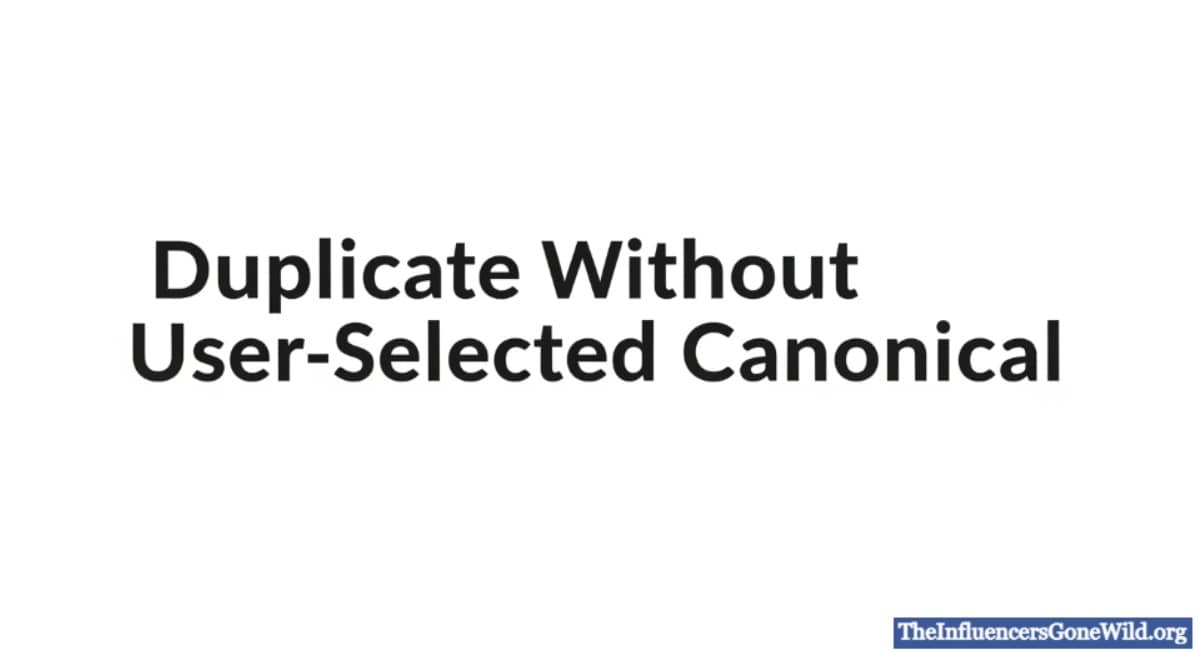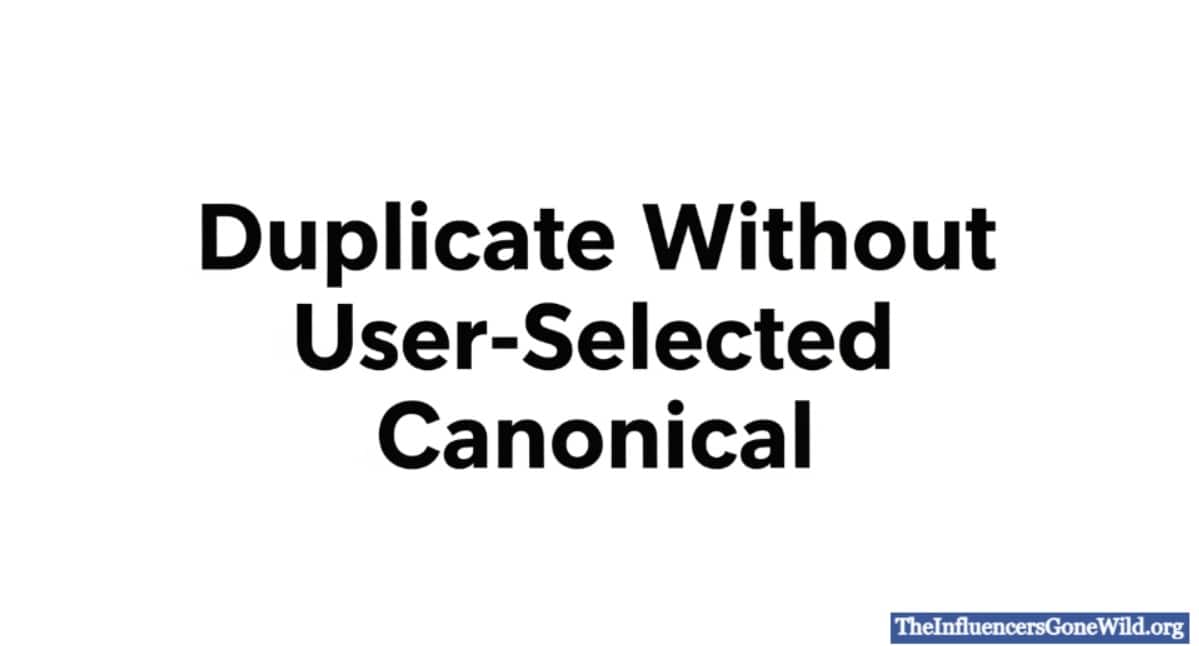Introduction
Imagine crafting valuable, original content only to find your search visibility plummeting due to a hidden issue. One of the most overlooked culprits in the world of technical SEO is duplicate content without a user-selected canonical.
Search engines hate confusion, and when you fail to guide them properly, they may index the wrong page or dilute your ranking authority.
This article will walk you through everything you need to know about this SEO warning—what it means, why it matters, how it affects your search performance, and how to fix it effectively.
What Does Duplicate Without User-Selected Canonical Mean?

The message “Duplicate without user-selected canonical” is a report often found in Google Search Console under the Index Coverage Report.
It indicates that Google has identified duplicate or near-duplicate pages, but you haven’t explicitly told it which one is the preferred (canonical) version.
In Other Words:
- Duplicate content exists across different URLs on your site.
- You did not use a canonical tag to inform Google which URL should be considered the main or authoritative version.
- Google decided for you, but it may not always pick the one you prefer.
Why Is This a Problem?
Search engines like Google aim to serve the best and most relevant content to users. If multiple pages on your site have similar or identical content:
- Your ranking signals (like backlinks) may be split between them.
- Google might index the wrong page, harming visibility and traffic.
- Your crawl budget is wasted, especially on large sites.
Real-World Impact:
- An eCommerce store with multiple filter/sort URLs showing the same product list.
- A blog with duplicate archives or print-friendly versions of articles.
- Pages served over both HTTP and HTTPS, or www and non-www.
Causes of Duplicate Content Without Canonical
Let’s break down the most common reasons why this issue arises:
1. URL Parameters
Search filters, session IDs, tracking codes, or pagination can all create unique URLs with similar content.
Example:
- example.com/products?category=shoes
- example.com/products?category=shoes&sort=price
2. WWW vs. Non-WWW and HTTP vs. HTTPS
Having versions of your site live on:
- http://example.com
- https://example.com
- http://www.example.com
- https://www.example.com
Without redirects or canonical tags causes duplication.
3. Session and Tracking URLs
Affiliate or marketing links can add identifiers to URLs that don’t change the page content.
4. Print-Friendly or Mobile Versions
Sites that serve alternative formats without specifying canonical links to the main version.
How Google Handles Duplicate Content
Google attempts to cluster duplicate pages and selects what it thinks is the best version to show in search. This process is known as canonicalization.
The Risk:
- You lose control.
- The wrong page might rank.
- You may see a drop in indexed pages or rankings.
How to Fix Duplicate Without User-Selected Canonical
Step 1: Identify the Affected Pages
Use Google Search Console:
- Go to Pages → Why pages aren’t indexed.
- Look for “Duplicate without user-selected canonical”.
- Export the list and analyze.
Step 2: Choose a Canonical Version for Each Group
Decide which URL version you want Google to prioritize.
Best practice: Choose the version with:
- Clean URL structure
- Most internal links
- Highest authority (e.g., backlinks)
Step 3: Implement Canonical Tags
Add the following tag in the <head> section of all duplicate pages:
html
CopyEdit
<link rel=”canonical” href=”https://www.example.com/preferred-page” />
Make sure it points to the correct version.
Step 4: Use 301 Redirects (If Appropriate)
If the duplicate page is unnecessary, use a 301 redirect to point it to the canonical version.
Warning: Only redirect when the pages are true duplicates, not slight variants.
Step 5: Update Internal Linking
Ensure all internal links point to the canonical version, not to duplicates or URLs with parameters.
Step 6: Use Robots.txt or Noindex (Selective)
Block unnecessary parameters or pages from being indexed using:
- robots.txt
- <meta name=”robots” content=”noindex, follow”>
Use with caution to avoid accidentally removing important content.
Best Practices to Avoid Future Issues
| Strategy | Description |
| Consistent URL Structure | Use a uniform format for all internal links. |
| Parameter Handling in GSC | Set rules in Google Search Console for how URL parameters should be treated. |
| Avoid Content Duplication | Consolidate similar pages; rewrite overlapping content. |
| Implement Canonical Tags | Standardize use across paginated and filter-based content. |
| Monitor Regularly | Check Google Search Console monthly for warnings or indexation issues. |
eCommerce Store Fix

An online shoe store was experiencing drops in organic traffic. Google had over 3,000 URLs marked as duplicate without canonical due to filtered navigation. After implementing:
- Canonical tags
- 301 redirects
- Updated internal linking
Within 60 days, organic traffic rose by 37%, and crawl errors dropped significantly..
Conclusion
The message “duplicate without user-selected canonical” is more than just a technical hiccup—it’s a warning that you’re giving up control over your site’s visibility.
With proper implementation of canonical tags, redirects, and best practices, you ensure that your preferred pages rank, your crawl budget is optimized, and your SEO strategy remains intact.
FAQs
What is a canonical tag?
A canonical tag is an HTML element that tells search engines which URL is the master copy of a page.
Can I have multiple canonical tags on a page?
No, you should have only one canonical tag per page. Multiple tags may confuse search engines.
Will Google always respect my canonical tag?
Not always. Google treats it as a strong suggestion but may override it if signals suggest otherwise.
Is it better to use canonical tags or 301 redirects?
Use canonical tags for pages that should remain accessible, and 301 redirects for obsolete or unnecessary pages.
Can I use self-referencing canonicals?
Yes, and it is recommended. It confirms the page is the preferred version.



